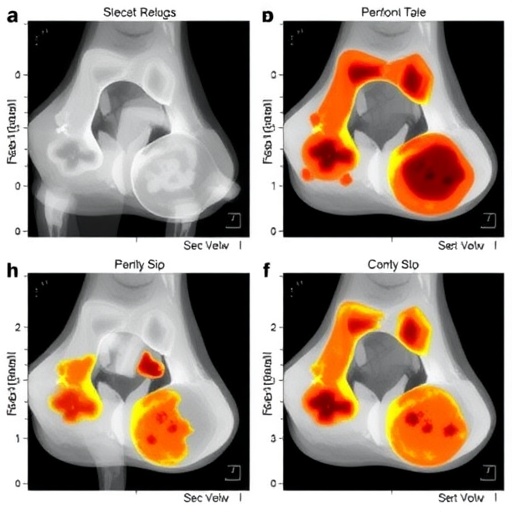New research indicates that young recreational and elite athletes commonly accumulate excess fluid in the bone marrow around the joint that connects the spine with the pelvis. The Arthritis & Rheumatology findings may help define what amount of fluid detected on imaging tests may be considered 'background noise' in physically active healthy individuals compared with patients who have axial spondyloarthropathy (axial Spa), an inflammatory disease with low back pain as its main symptom.
The research was conducted to improve the diagnosis of axial Spa, which most commonly affects people in their teens and 20s, especially young men. Bone marrow edema, or the accumulation of excess fluid in bone marrow, in the sacroiliac joint is an inflammatory process thought to play a major role in the disease. Magnetic resonance imaging (MRI) can detect bone marrow edema and structural changes in the sacroiliac joint when patients begin to experience pain, but there is ongoing debate about what constitutes a positive MRI for the diagnosis of axial SpA early in the course of the disease.
To provide some clarity, Ulrich Weber, MD, a researcher at King Christian 10th Hospital for Rheumatic Diseases in Gråsten, Denmark and his colleagues conducted a study of 20 recreational runners and 22 professional ice hockey players to determine the frequency of bone marrow edema and its distribution across eight regions of the sacroiliac joint. The runners received MRI scans of their sacroiliac joints before and 24 hours after a 6.2-km competitive run, and the hockey players received scans at the end of their competitive season.
The average number of sacroiliac joint quadrants showing bone marrow edema in the healthy runners was 3.1 before and after running, and 3.6 in the hockey players. The posterior lower ilium was the most affected region, followed by the anterior upper sacrum.
"Our study in individuals experiencing a broad span of mechanical strain intensity to the axial skeleton contributes several issues to refine a definition of about what constitutes a positive lesion signature on sacroiliac joint MRI," said Dr. Weber. "Limited specificity of sacroiliac joint bone marrow edema is highlighted by the study finding that one out of three healthy athletes would meet the currently most widely applied classification criteria for SpA based solely on bone marrow edema. This has impacts concerning where to set the threshold for between normal variation and disease." Dr. Weber noted that the finding that edema occurs in two anatomical regions of the sacroiliac joint in healthy individuals is also noteworthy. "The presence of solely low grade bone marrow edema, particularly if clustered in the posterior lower ilium or anterior upper sacrum, may not be sufficient to confirm axial SpA," he said. The study did not reveal any relevant structural changes in the sacroiliac joints of healthy individuals, despite high mechanical axial strain from their sport. Therefore, structural changes such as erosion may be key for discriminating disease from normal variations.
###
Additional Information
The information contained in this release is protected by copyright. Members of the media may sign up for embargoed news or to request a copy of any study please contact:
Dawn Peters (US) +1 781-388-8408
[email protected]
Follow us on Twitter @WileyNews
Full Citation: "Frequency and anatomical distribution of magnetic resonance imaging features in sacroiliac joints of young athletes." Ulrich Weber, Anne Grethe Jurik, Anna Zejden, Ejnar Larsen, Steen Hylgaard Jørgensen, Kaspar Rufibach, Christian Schioldan, and Søren Schmidt-Olsen. Arthritis & Rheumatology; Published Online: Feb 12, 2018. (DOI: 10.1002/art.40429).
URL Upon Publication: http://doi.wiley.com/10.1002/art.40429
Author Contact: Anne Reinholdt ([email protected]) or Kirsten Palmer ([email protected])
For senior author, Dr. Schmidt-Olsen: Camilla Brandt ([email protected])
About the Journal
Arthritis & Rheumatology is an official journal of the American College of Rheumatology (ACR) and covers all aspects of inflammatory disease. The American College of Rheumatology is the professional organization whose members share a dedication to healing, preventing disability, and curing the more than 100 types of arthritis and related disabling and sometimes fatal disorders of the joints, muscles, and bones. Members include practicing physicians, research scientists, nurses, physical and occupational therapists, psychologists, and social workers. The journal is published by Wiley on behalf of the ACR. For more information, please visit http://wileyonlinelibrary.com/journal/art.
About Wiley
Wiley, a global research and learning company, helps people and organizations develop the skills and knowledge they need to succeed. Our online scientific, technical, medical, and scholarly journals, combined with our digital learning, assessment and certification solutions help universities, learned societies, businesses, governments and individuals increase the academic and professional impact of their work. For more than 210 years, we have delivered consistent performance to our stakeholders. The company's website can be accessed at http://www.wiley.com.
Media Contact
Dawn Peters
[email protected]
781-388-8408
http://newsroom.wiley.com/
http://dx.doi.org/10.1002/art.40429




